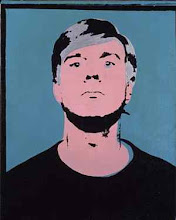 |
| Kazimir Malevich, Black Square, '1913'/1915 |
In his very entertaining book, 1913: The Year before the Storm, Florian Illies cites that year as the zero point of modern art:
"In December 1913 the first 'ready-made', the bicycle wheel on a wooden stool, is turning at the hand of Marcel Duchamp in Paris, while the first 'Black Square' comes into being in Moscow - the twin starting-points of modern art... We should always think of the 'Black Square' when we think of 1913." (Illies (2013) p247)
However, the precise dating of 'Black Square' is tricky: the image above appears on the Tate's website and is labelled 1913 - but, most accounts (including the Tate's) state that Malevich actually painted the first Black Square in 1915 and subsequent versions in 1923 and 1929 and a final one possibly in the early 30s which was dated '1913'! Malevich's rationale for the latter move was that the idea was conceived in 1913 - and, indeed, his 1913 stage designs for the Russian Futurist opera Victory over the Sun do anticipate the iconic Black Square.
 |
| Kazimir Malevich, Stage design for 'Victory over the Sun', 1913 |
This exhibition presents an overview of Malevich's remarkably varied and radical work - he, effectively, worked through the avant-garde styles of the early 20th century - Fauvism, Futurism, Cubism - before arriving at the revolutionary, abstract style he called Suprematism, launched at the "0.10" exhibition in Petrograd in December 1915. Malevich later returned to figuration in the 1920s.
Read reviews by Laura Cumming, Adrian Searle, Waldemar Januszczak, Andrew Lambirth, Claudia Pritchard, and an article by Frances Spalding: Kazimir Malevich:The Man Who Liberated Painting.
 |
| Kazimir Malevich, Self-Portrait, 1908-10 |
 |
| Kazimir Malevich, Shroud of Christ, 1908 |
 |
| Kazimir Malevich, The Woodcutter, 1912 |
 |
| Kazimir Malevich, Englishman in Moscow, 1914 |
 |
| View of "0.10" exhibition in Petrograd, 1915 |
 |
| Kazimir Malevich, Red Square (Painterly Realism of a Peasant Woman in Two Dimensions), 1915 |
 |
| Kazimir Malevich, Suprematist Painting (with Black Trapezium and Red Square), 1915 |
 |
| Kazimir Malevich, White on White, 1918 |
 |
| Kazimir Malevich, Woman Worker, 1933 |
 |
| Kazimir Malevich, Self-Portrait, 1933 |

